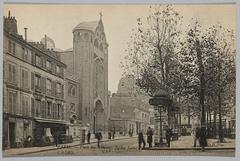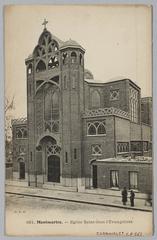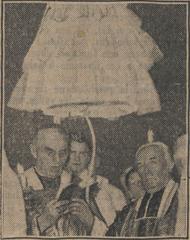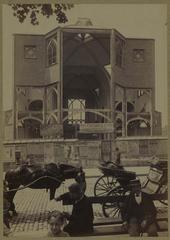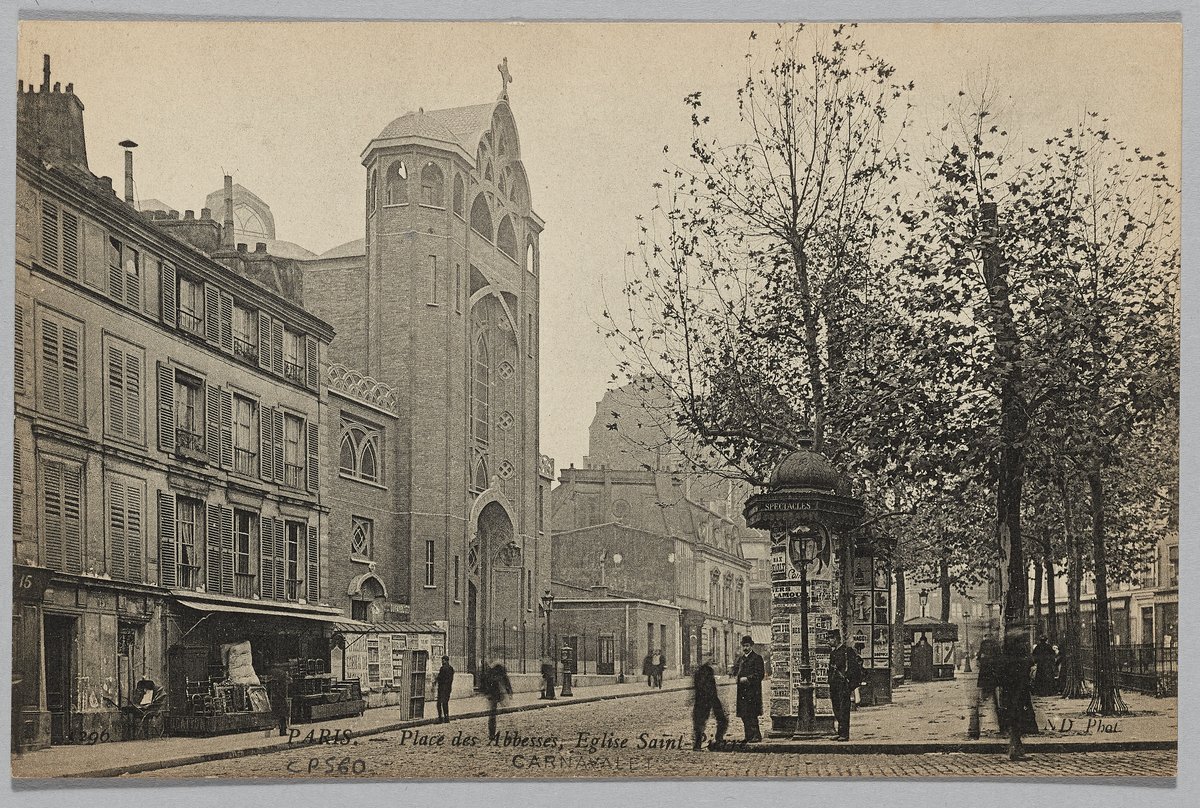
Saint-Jean-de-Montmartre: Visiting Hours, Tickets, and Comprehensive Guide to a Paris Historical Treasure
Date: 14/06/2025
Introduction
Saint-Jean-de-Montmartre, nestled in the heart of the iconic Montmartre district, is more than just a church—it’s a testament to Parisian innovation, artistic heritage, and community spirit. Renowned as the first church in France constructed primarily from reinforced concrete, it stands as a bold statement of architectural progress and the Art Nouveau movement at the turn of the 20th century. Designed by Anatole de Baudot and executed with the engineering brilliance of Paul Cottancin, the church blends cutting-edge construction with the organic artistry of the era (Monumentum, montmartre.io).
Strategically located at 19 rue des Abbesses, Saint-Jean-de-Montmartre serves as both a spiritual sanctuary and a vibrant cultural hub. Its façade—distinguished by polychrome brickwork and Alexandre Bigot’s ceramic mosaics—immediately sets it apart from neighboring landmarks, notably the Sacré-Cœur Basilica (Paris Zigzag). Inside, luminous stained glass and intricate ironwork invite visitors to appreciate both the spiritual and artistic richness of this Paris historical site. The church remains a living center for worship, music, exhibitions, and community events, embodying Montmartre’s enduring bohemian spirit (Connolly Cove).
This guide provides detailed visiting hours, ticketing information, accessibility details, travel tips, and in-depth insights into the church’s history and cultural significance, ensuring an enriching visit to one of Paris’s most unique historical sites.
Contents
- Origins and Historical Context
- Architectural Innovation and Art Nouveau Significance
- Construction Challenges and Heritage Status
- Visiting Hours, Tickets, and Practical Information
- Accessibility and Getting There
- Architectural Features & Artistic Highlights
- Community Events and Cultural Engagement
- Nearby Attractions and Suggested Itinerary
- Visitor Tips and Frequently Asked Questions (FAQ)
- Summary and Recommendations
- Sources and Further Reading
Origins and Historical Context
The late 19th century witnessed Montmartre’s transformation from a rural village into a bustling Parisian neighborhood, especially after its annexation in the 1860s (Salut Byebye). As the population grew, the need for a new parish church became apparent. The vision for Saint-Jean-de-Montmartre was championed by Abbé Sobaux, who sought to serve residents along the lower slopes of the Butte Montmartre, making worship more accessible than at the hilltop Saint-Pierre de Montmartre (Saint Jean de Montmartre Parish).
The chosen site at rue des Abbesses symbolized a bridge between the old village and modern city, and also presented a technical challenge due to its sloping terrain and underlying quarries—a challenge that would necessitate architectural innovation.
Architectural Innovation and Art Nouveau Significance
Reinforced Concrete Revolution
Saint-Jean-de-Montmartre is celebrated as the first church in France to use reinforced concrete as its primary structural material, marking a pivotal moment in modern architecture (Monumentum, Parishistoire Vivante). Anatole de Baudot, inspired by his mentor Eugène Viollet-le-Duc, prioritized structural honesty and clarity. Working with engineer Paul Cottancin, he applied an innovative system of brick and metal rods embedded in concrete, enabling slender columns and ribbed domes that allowed for open, light-filled interiors previously unachievable with stone.
Art Nouveau Flourishes
The exterior distinguishes itself with polychrome brickwork and Art Nouveau ceramics by Alexandre Bigot, featuring stylized organic motifs and flowing lines. The decorative program, both inside and out, integrates ceramics, mosaics, stained glass, and ironwork, reflecting the unity of art and architecture that defines the Art Nouveau movement (montmartre.io). The design stands in stark contrast to the nearby neo-Romanesque Sacré-Cœur, asserting a modern, progressive identity for Montmartre.
Construction Challenges and Heritage Status
Technical and Administrative Hurdles
The use of reinforced concrete was met with skepticism by both city authorities and the church hierarchy. Concerns over safety, aesthetics, and long-term durability led to construction delays and repeated technical assessments (Visiting Paris By Yourself). The steep site complicated matters, requiring innovative engineering solutions. Despite these challenges, the church was completed in 1904, and its rich interior decoration—including Jacques Galland’s stained glass and Gueniot’s marble angels—followed in subsequent years (WikiArquitectura).
Monument Historique Status
Initially controversial, Saint-Jean-de-Montmartre’s architectural value has since gained wide recognition. In 2014, it was officially designated a Monument Historique, ensuring its preservation for future generations (Monumentum).
Visiting Hours, Tickets, and Practical Information
- Opening Hours: Daily, 9:00 AM – 6:00 PM (may vary on holidays; check parish website for updates).
- Tickets and Entry: Admission is free. Donations are welcome to support maintenance and community programs.
- Guided Tours: Offered on the fourth Sunday of each month at 4:00 PM, focusing on architecture and history.
- Photography: Allowed, but please be respectful during services and avoid flash.
Accessibility and Getting There
- Location: 19 rue des Abbesses, 75018 Paris, at Place des Abbesses.
- Metro: Abbesses station (Line 12) is adjacent. Note that it is one of Paris’s deepest stations; elevators are available (pariste.net).
- Wheelchair Access: The main entrance is wheelchair accessible; interior navigation is generally good, but some areas may have steps. Contact the parish for specific needs.
- Travel Tip: Wear comfortable shoes for Montmartre’s cobblestone streets and hilly terrain.
Architectural Features & Artistic Highlights
- Façade: Warm red brick and ceramic mosaics with Art Nouveau motifs by Alexandre Bigot.
- Interior: Three naves with slender concrete columns and ribbed vaults, creating a luminous, open space (montmartre.io).
- Stained Glass: Vibrant Art Nouveau windows by Jacques Galland.
- Organ: A historic Cavaillé-Coll organ enriches concerts and services (travelfranceonline.com).
- Decorative Ironwork: Whiplash curves and botanical motifs in doors and railings.
Community Events and Cultural Engagement
Saint-Jean-de-Montmartre is a hub for the local community, hosting concerts, art exhibitions, and social events. It actively participates in Montmartre festivals such as the Fête des Vendanges and supports outreach programs, blending its spiritual mission with cultural and social engagement (Connolly Cove).
Nearby Attractions and Suggested Itinerary
Within Easy Walking Distance:
- Le Mur des Je t’Aime: “I Love You Wall” across Place des Abbesses (pariste.net)
- Sacré-Cœur Basilica: Montmartre’s iconic white-domed landmark
- Place du Tertre: Artistic heart of Montmartre, buzzing with painters and cafés
- Saint-Pierre de Montmartre: One of the city’s oldest churches
- Montmartre Vineyards (Clos Montmartre): Especially lively during the annual harvest festival
- Moulin Rouge and Pigalle: Legendary nightlife within walking distance
Dining: Abbesses neighborhood offers classic Parisian cafés and bistros, such as Café Sancerre and Bouillon Pigalle (dreamsinparis.com).
Suggested Itinerary:
Begin at Saint-Jean-de-Montmartre, stroll through Place des Abbesses, visit Le Mur des Je t’Aime, ascend to Sacré-Cœur with stops at Place du Tertre and Saint-Pierre, and conclude your tour via Rue Lepic or the vineyards down to Moulin Rouge (fullsuitcase.com).
Visitor Tips and Frequently Asked Questions (FAQ)
General Tips:
- Visit early morning or late afternoon to avoid crowds.
- Dress modestly and maintain silence inside the church.
- Bring a camera for the unique architectural details and panoramic Montmartre views.
FAQ
-
Q: What are the visiting hours?
A: Daily, 9:00 AM – 6:00 PM (subject to change on holidays). -
Q: Is there an entrance fee?
A: No, entry is free. -
Q: Are guided tours available?
A: Yes, on the fourth Sunday of each month; special tours during festivals and events. -
Q: Is the church wheelchair accessible?
A: Yes, via the main entrance. -
Q: Can I take photographs inside?
A: Yes, but avoid flash and respect worshippers. -
Q: How do I get there?
A: Metro Line 12 to Abbesses; elevators available at station.
Summary and Recommendations
Saint-Jean-de-Montmartre stands as a beacon of architectural daring and artistic vibrancy in Paris, bridging tradition and modernity. Its pioneering use of reinforced concrete and dazzling Art Nouveau details make it a must-see for architecture enthusiasts and cultural explorers alike. The church’s active role in community life and its central location near major Montmartre attractions further enhance its appeal (Monumentum, Connolly Cove, Paris Eater).
Plan your visit by checking the latest hours, exploring nearby highlights, and immersing yourself in the living history of Montmartre. For up-to-date event information, download the Audiala app and explore more on Paris historical sites.
Sources and Further Reading
- Salut Byebye - Montmartre District Paris
- Saint-Jean-de-Montmartre Parish
- Monumentum - Eglise Saint-Jean-de-Montmartre
- montmartre.io - L’Eglise Saint-Jean-de-Montmartre
- Parishistoire Vivante - Saint-Jean-de-Montmartre
- Visiting Paris By Yourself - Saint-Jean-de-Montmartre
- Connolly Cove - Bohemian Artists of Paris Montmartre
- Paris Eater - 12 Amazing Things to Do & See in Montmartre
- Paris Zigzag - Histoire insolite de l’Eglise Saint-Jean-de-Montmartre
- travelfranceonline.com - Saint-Jean-de-Montmartre Art Nouveau
- pariste.net - Church of Saint-Jean in Montmartre
- fullsuitcase.com - Montmartre Things to Do
- dreamsinparis.com - Things to Do in Montmartre
- paristouristinformation.fr - Montmartre District Guide
- salutfromparis.com - Things to Do in Montmartre
- Snippets of Paris - Montmartre
